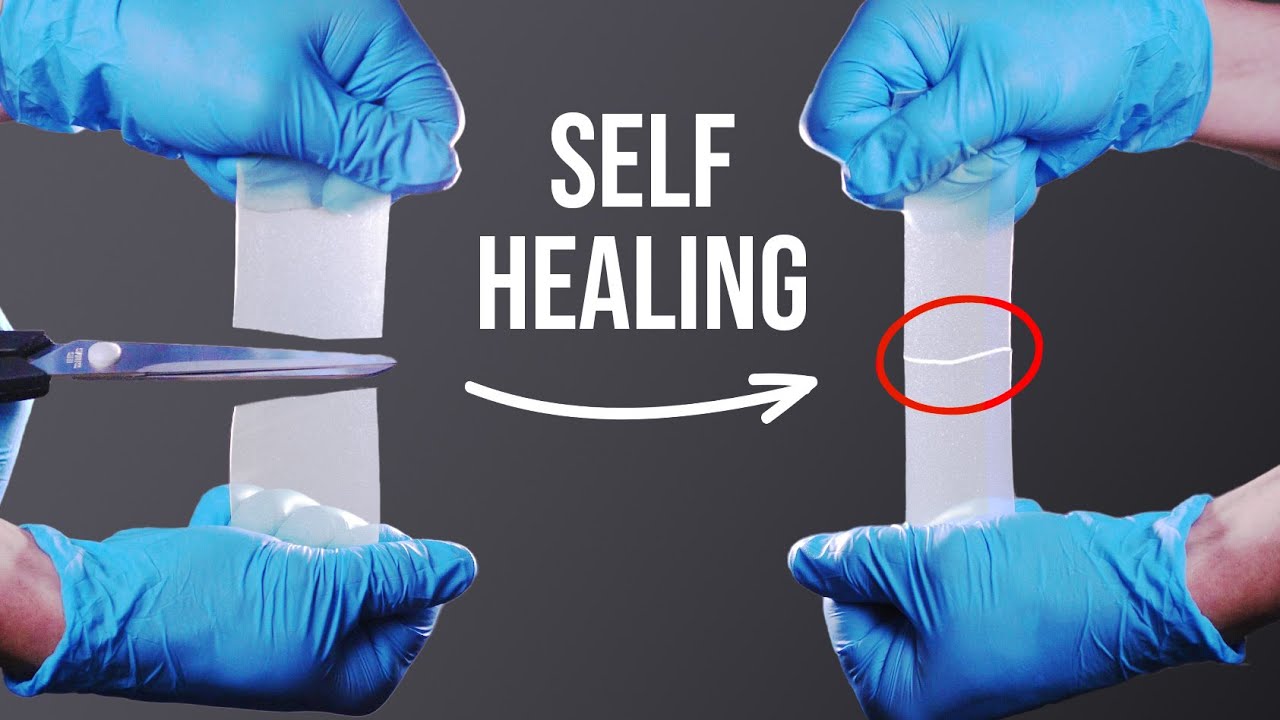The Rise of Self-Healing Polymers
A Promising Solution for Enhanced Durability and Sustainability


Introduction:
As the world continues to seek innovative and sustainable solutions to address various challenges, advanced polymers, particularly self-healing materials, have gained significant interest. These materials possess the unique ability to repair themselves when damaged, leading to increased durability and potentially reducing waste. Researchers have made remarkable progress in designing self-healing polymers with enhanced mechanical properties, faster healing times, and greater environmental stability.
The Science Behind Self-Healing Polymers:
Self-healing polymers are materials designed to mimic the natural self-repair processes observed in biological systems. The healing mechanisms in these polymers can be broadly classified into two categories: intrinsic and extrinsic self-healing. Intrinsic self-healing polymers involve the reformation of broken chemical bonds within the material, while extrinsic self-healing polymers rely on the release of healing agents from microcapsules or vascular networks embedded within the material.
Recent Advancements in Self-Healing Polymer Technology: Researchers have been working diligently to develop self-healing polymers with improved properties. Key advancements in this field include:
-
Enhanced mechanical properties:
New self-healing polymers are being developed with superior mechanical properties, such as increased strength and flexibility, making them suitable for use in various applications, from consumer products to aerospace and automotive industries.
-
Faster healing times:
Researchers are exploring novel healing mechanisms and polymer compositions to accelerate the healing process. This enables materials to recover quickly from damage, ensuring minimal downtime and improved performance.
-
Improved environmental stability:
Developing self-healing polymers with greater resistance to environmental factors, such as temperature, humidity, and UV radiation, is crucial for their longevity and effectiveness in real-world applications.
Potential Applications of Self-Healing Polymers:
The unique properties of self-healing polymers make them suitable for a wide range of applications, including:
-
Automotive and aerospace:
Self-healing polymers can be used in the manufacturing of vehicle parts and aircraft components, enhancing their durability and reducing maintenance costs.
-
Electronics:
Incorporating self-healing polymers in electronic devices, such as smartphones and wearables, can improve their resilience to damage and extend their lifespan.
-
Construction materials:
Self-healing polymers can be integrated into construction materials, such as concrete and coatings, to improve the durability of infrastructure and reduce maintenance costs.
-
Biomedical applications:
Self-healing polymers show promise in the development of advanced drug delivery systems and tissue engineering scaffolds, facilitating targeted drug release and promoting tissue regeneration.
Reaserch and Development Timeline
Creating a comprehensive timeline for the development of self-healing polymers by individual research groups is quite challenging, as this field has seen significant contributions from numerous researchers over the years. However, I can provide you with a general timeline that highlights some of the key milestones and breakthroughs in the field:
1990s:
- Early research on self-healing materials focused primarily on embedding microcapsules containing healing agents within a polymer matrix.
2001:
- Prof. Scott R. White and his research group at the University of Illinois at Urbana-Champaign published a landmark paper in the journal Nature, demonstrating the first example of a self-healing polymer with microencapsulated healing agents and a catalyst embedded in the polymer matrix.
2007:
- Prof. Wolfgang H. Binder and his research group at the Martin Luther University Halle-Wittenberg in Germany reported the development of a self-healing polymer using reversible Diels-Alder chemistry.
2010s:
- Research in the field of self-healing polymers expanded, with numerous research groups exploring different strategies, including supramolecular polymers, shape-memory materials, and reversible covalent bond formation.
2011:
- Prof. Zhenan Bao and her research group at Stanford University developed a self-healing electronic skin, which could be used in robotics and prosthetics.
2013:
- Prof. Marek W. Urban and his research group at Clemson University reported a self-healing polymer that changes color when damaged and repairs itself when exposed to visible light.
2015:
- Prof. Santiago J. García and his research group at Eindhoven University of Technology in the Netherlands published their work on self-healing coatings using reversible hydrogen-bonding interactions.
This timeline provides only a brief overview of the development of self-healing polymers, and there are many more research groups and breakthroughs that have contributed to the growth of this field. The progress in self-healing polymers continues to accelerate, with ongoing research focused on improving the efficiency, versatility, and scalability of these materials for various applications.
Below is a list of other research groups from each continent that are actively working on self-healing polymers and related materials:
North America:
- Sottos Research Group, University of Illinois at Urbana-Champaign, USA - Led by Prof. Nancy R. Sottos, this group investigates the design and mechanics of self-healing materials and their applications in various fields.
Europe:
- Binder Research Group, Leibniz Institute of Polymer Research Dresden, Germany - Led by Prof. Brigitte Voit-Binder, this group focuses on the design and synthesis of self-healing polymers and their potential applications.
Asia:
- Chen Research Group, Zhejiang University, China - Led by Prof. Yongming Chen, this group investigates the development of self-healing polymers, particularly in the context of stimuli-responsive materials and their applications.
- Ghosh Research Group, Indian Institute of Science, India - Led by Prof. Suhrit Ghosh, this group explores the design and synthesis of self-healing polymers, with a focus on supramolecular chemistry and stimuli-responsive materials.
Australia:
- Huang Research Group, The University of Queensland, Australia - Led by Prof. Xiaodong Huang, this group investigates the development of self-healing polymers and coatings, as well as the design of smart materials for various applications.
- Zetterlund Research Group, University of New South Wales, Australia - Led by Prof. Per B. Zetterlund, this group focuses on the synthesis of self-healing polymers and the development of nanocomposite materials with self-repairing properties.
South America:
- Mauler Research Group, Universidade Federal do Rio Grande do Sul, Brazil - Led by Prof. Raquel Santos Mauler, this group investigates the development of self-healing polymeric materials, particularly in the context of smart coatings and protective applications.
- López Research Group, National University of Colombia, Colombia - Led by Prof. Freddy E. López, this group explores the synthesis and characterization of self-healing polymers, with a focus on their potential applications in various industries.
Africa:
- Ogunlana Research Group, University of Lagos, Nigeria - Led by Prof. Olusegun O. Ogunlana, this group investigates the development of self-healing polymers, particularly in the context of natural polymers and their applications in drug delivery and tissue engineering.
- Motaung Research Group, University of the Free State, South Africa - Led by Prof. Teboho Motaung, this group focuses on the synthesis and characterization of self-healing polymers and their potential applications in various fields, including drug delivery and environmental remediation.
Commercialized self-healing products:
Commercialized self-healing products are relatively limited, as the field is still emerging and many developments remain in the research phase. However, there are some manufacturers that have started incorporating self-healing properties into their products. Here are a few examples:
-
Autonomic Materials Inc.
(AMI): Based in the United States, AMI specializes in self-healing coatings and adhesives for various applications. They offer a range of products, including self-healing epoxy, polyurethane, and acrylic coatings that can be used in the aerospace, automotive, and construction industries.
-
NEI Corporation:
This US-based company develops and manufactures advanced materials, including self-healing coatings for metal, plastic, and glass surfaces. Their NANOMYTE® MEND product line features coatings with self-healing properties for applications in the electronics, automotive, and aerospace industries.
-
Arkema:
A French chemical company, Arkema has developed a range of self-healing materials under their Rilsan® brand. These materials are primarily used in automotive applications, such as fuel lines and tubing, where they help increase the durability and lifespan of components.
-
Nissan:
The Japanese automotive manufacturer introduced a self-healing paint called "Scratch Shield" for some of their vehicles. This paint uses a special polymer that can repair minor scratches and scuffs by reflowing and filling in the damaged area over time.
-
Apple:
In 2020, Apple was granted a patent for a self-healing material that could potentially be used in future electronic devices, such as smartphones and tablets. Although not yet commercialized, this development highlights the growing interest in self-healing materials among major manufacturers.
It is important to note that while these examples represent some of the first steps toward commercializing self-healing materials, many other developments are still in the research and development phase. As the field advances and more self-healing materials are brought to market, we can expect to see a wider range of products and applications in the coming years.
Reversible Adaptable Polymers (RAPs)
EURECAT - A Promising Approach in Self-Healing Materials
Eurecat, a Spanish technology research and development center, has pioneered a groundbreaking technology called "Reversible Adaptable Polymers" (RAPs). This innovative technique enables strong bonding between two severed sections of a tube or pipe and can be applied to various materials such as polymers, composites, or elastomers. The bonding process, initiated by applying pressure, is reversible, allowing the bond to be undone and re-established multiple times.
RAPs technology presents a novel approach to creating self-healing materials with potential applications across numerous industries, including automotive, aerospace, construction, and oil and gas. By harnessing the distinct properties of these reversible adaptable polymers, Eurecat aims to develop solutions that enhance the durability and sustainability of materials while minimizing waste and maintenance costs.
What sets RAPs apart is their unique mechanism for reversible bonding, which facilitates robust adhesion between two disconnected parts of a tube or pipe. This versatile technology can be employed across a wide range of materials, making it highly adaptable for use in multiple industries.
The captivating aspect of RAPs stems from their ability to form strong bonds by merely applying pressure. This process, which is not only reversible but also capable of re-establishing the bond multiple times, presents a sustainable approach to material repair and waste reduction. RAPs have the potential to impact several sectors, including automotive, aerospace, construction, and oil and gas.
While the term "Reversible Adaptable Polymers" (RAPs) is specifically used by Eurecat, the concept of reversible bonding in polymers is an area of active research and development in material science. Several other companies and research institutes are working on materials with similar self-healing or reversible bonding properties. Here are a few examples:
-
IBM Research - Almaden:
Researchers at IBM's Almaden Research Center have developed a new class of polymers called "Polyhexahydrotriazines" (PHTs) that exhibit self-healing properties through reversible bonding. These materials can recover their original strength after being damaged, making them suitable for various applications, such as coatings and adhesives.
-
Ionomr Innovations Inc.:
A Canadian startup, Ionomr Innovations, has developed a novel class of ion-exchange membranes called "Aemion™." These materials feature reversible bonding capabilities, which can be utilized for applications in energy storage, water treatment, and other industries.
-
University of Illinois at Urbana-Champaign:
Researchers at this university have developed self-healing materials based on supramolecular polymers that exhibit reversible bonding. These materials can be used in applications such as coatings, adhesives, and elastomers, where the ability to self-heal and re-establish bonds is highly desirable.
-
University of Groningen:
Researchers at this Dutch university have developed a self-healing polymer based on reversible Diels-Alder chemistry. This polymer can be used in coatings, adhesives, and other applications where reversible bonding and self-healing properties are desired.
While these examples use different approaches and terminologies, they all focus on the development of materials with reversible bonding and self-healing properties. This area of research continues to expand, and we can expect further advancements and commercial applications in the coming years.
Conclusion:
The development of self-healing polymers represents an exciting breakthrough in material science, offering the potential to revolutionize various industries by enhancing durability, reducing waste, and promoting sustainability. As research and development in this field continue to progress, we can expect to see the widespread adoption of self-healing polymers in a myriad of applications, paving the way for a more resilient and sustainable future.